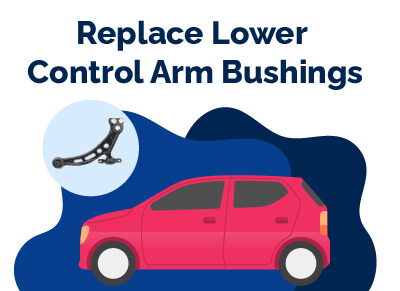Replacing Lower Control Arm Bushings
July 21, 2023


Chris is Head of Content for FindTheBestCarPrice and is based out of Philadelphia, PA. As a seasoned automotive industry analyst and car enthusiast, he ensures the highest level of quality across all our content and curates our picks for the best deals each month.
Chris studied information systems and marketing at Drexel University and writes about a wide range of topics ranging from car buying tips to troubleshooting common mechanical issues.
When he’s not thinking about cars, he likes to stay in with his dog and make an “attempt” to finish a crossword puzzle (he’s not quite at the Saturday/Sunday level…yet). As a former cheesemonger, Chris still has a “sharp” passion for all things cheese, and his fridge is always loaded with it!
Chris also has a passion for things that go fast, and drones are no exception. He spends some of his time writing for Dronesourced.
The lower control arm has a pair of elastic bushings, a metallic structure, and a pivotal joint. This arm is between the vehicle's framework and the spindle or wheel hub. Although every automobile has these arms, the quantity may differ.
The arms facilitate the oscillating motion of the front wheels as they encounter potholes or other impediments on the road. If you are experiencing a faulty lower control arm, addressing the issue as promptly as possible is imperative.
The longer you procrastinate, the more complications you will encounter.
If you have identified that one of your lower control arms is no longer functional, substituting it is the subsequent course of action.
So, this article will expose you to the needed steps for replacing lower control arm bushings.
Table of Contents
Steps for Replacing Lower Control Arm Bushings
To replace lower control arm bushings, you must first disengage the wheel and elevate the vehicle using jack stands while supporting it. Additionally, it is crucial to equip yourself with protective eyewear and gloves.
1. Release the Ball Joint
The initial step involves the disengagement of the ball joint. This can be accomplished by employing a sizable wrench ranging from 20mm to 24mm or a socket to loosen the ball joint nut after eliminating the cotter pin.
Subsequently, by striking the spindle or the control arm bulkhead with a hammer, the taper fit is "shocked" loose.
2. Remove the Sway Bar Link
The sway bar is connected to the control arm via the sway bar link. Extract the nut utilizing a 14mm or 15mm wrench or socket.
There could be a small taper fit for this connection; hence, you may have to "shock" it loose, similar to the ball joint.
Grasp the sway bar link away from the lower control arm mount. This will enable the sway bar link to remain out of the way during the task.
3. Remove the Control Mounting Bolts
There are two mounting bolts for the control arm, which may be oriented horizontally or vertically. Use a wrench or socket from 19mm to 22mm to loosen and detach the bolts.
Some bolts may have a nut on the backside, necessitating an additional wrench to hold it in place. These bolts may be tight, so ensure the socket or wrench is securely fastened onto the bolt head to avoid rounding.
A universal joint and socket may be used to remove the rear control arm bolt to make the task easier. After the bolts have been extracted, the arm may be unsteady, so keep your hands on it.
4. Remove the Lower Control Arm
If the control arm is still firmly in its mounts, grab the arm and pull it outward to remove it from the frame mounts.
5. Replace the Bushings
If you are only replacing the bushings, ensure that the new bushing matches the old one in the control arm.
A press will be necessary to remove the old bushings and install the new unit. First, mark the orientation to ensure proper installation of the new bushing.
Incorrect installation may cause the bushing to tear and malfunction. Ensure that the flex section of the new bushing is located in the same position as the original.
Place the lower control arm into a hydraulic press; there will be an audible "pop" when the bushing begins to move. Continue pressing the bushing until it is entirely removed from the arm.
The control arm will become unsteady when the operation is completed. You can then release the press and remove the arm.
Insert the new bushing into the lower control arm while keeping an eye on the marks you made from the old bushing. Avoid applying lubrication to the bushing case because it will allow it to shift out of the arm during use.
Align the press and gradually force the new bushing into place. Ensure the bushing remains straight during the initial press to avoid distorting the housing. The bushing will remain straight once the pressing begins.
Confirm that the new bushing has been fully installed, and repeat this process for the opposing unit. Once completed, the control arm is ready to be reinstalled.
6. Reinstall the Lower Control Arm
Skillfully wedge the bushing into the frame mounts as you grasp the newly replaced or refurbished lower control arm.
While doing so, you may need to apply an upward and downward motion, pushing inward on the control arm to make the fitting possible.
Observe the bolt holes during reinstallation to align them with the corresponding holes in the frame. A screwdriver may help achieve proper alignment.
Once properly aligned, insert the control arm mounting bolts by hand to prevent the threads from becoming crossed. However, refrain from tightening them until all bolts, including the ball joint, are in place.
Then, position the lower ball joint and fit it into the control arm, installing the nut by hand. Place the sway bar link in the control arm, and reattach it with the nut.
After all nuts and bolts are in place, secure the front arm mounting bolt, adhering to the manufacturer's torque specifications, typically between 65 and 75 foot-pounds. A universal socket and extension are handy when tightening the control arm bolts.
Next, tighten the lower ball joint castle nut while aligning the cotter pin holes. Once the nut is taut, insert the cotter pin, a safety measure to prevent the nut from becoming loose.
As you tighten the nut holding the sway bar link in place, use your other hand to hold the link still. Reattach the wheel, and lower the car off the jack stands.
We highly recommend having the vehicle aligned. During the initial drive, listen for any atypical noises, which may indicate that the job needs to be reassessed.
Causes of Lower Control Arm Bushing Noise
An individual who lacks automotive knowledge may struggle to comprehend the source of unusual clunking sounds emanating from their vehicle.
Despite various factors that can produce atypical noises, a faulty lower control arm bushing will generate very particular sounds, almost akin to knocking, originating from the control arm vicinity.
The following are the most frequent culprits responsible for the lower control arm bushing noise:
1. Loose Bushings
In the event of a loose lower control arm bushing, it will experience erratic movements between the enclosing metallic components.
It is only sometimes indicative of a worn bushing. It may be the consequence of driving over a bump that loosened it or a mechanic inadvertently loosened it while performing maintenance on another part of your vehicle.
However, the consequence of loose bushings is uniform, with persistent and identical knocking sounds.
2. Driving Over Uneven Topography
Traversing over uneven topography, like rough gravel or a bumpy roadway, can intensify the auditory disturbance of knocking or clunking emanating from the lower control arm area.
While a well-maintained bushing should remain stable and not vibrate from such rough driving, an unfastened bushing may be subject to further destabilization due to the inconsistent motion of the vehicle.
3. Worn-out Bushings
Bushings are subject to wear and tear and will not last indefinitely. The longer your vehicle is driven, the more pronounced the wear and tear on the lower control arm bushing will be.
Initially, you may notice a faint knocking noise, but as the bushing's condition worsens, the knocking will become increasingly loud and persistent.
4. Broken Control Arm Bushing
The lower control arm bushing may fracture due to excessive wear and tear, or it could have sustained accidental damage from a mechanic tending to a separate vehicle component.
In such cases, the ruptured bushing will generate loud and conspicuous clunking sounds, which won't be progressively amplified like the deteriorating bushings.
5. When You Accelerate Hard
Loose bushings will manifest their knocking sounds most prominently during the initial acceleration of your vehicle from a standstill.
Specifically, when your vehicle is parked, and you shift gears to drive and press down firmly on the gas pedal, the knocking sounds will resonate most audibly now.
Best Car Deals by Category
Frequently Asked Questions
Can I replace just one lower control arm bushing, or do I need to replace both?
It is recommended to replace both lower control arm bushings simultaneously, even if only one is worn out. This is because the bushings usually wear out at a similar rate, and replacing both simultaneously ensures that your suspension system will be adequately balanced.
Can I replace the lower control arm bushings myself or take it to a mechanic?
Replacing lower control arm bushings can be a complex task and requires specialized tools, so it is recommended to have a professional mechanic handle the job. However, if you have extensive knowledge and experience in car repair, replacing the bushings yourself with the proper tools and instructions may be possible.
How long do lower control arm bushings last?
The lifespan of lower control arm bushings can vary depending on driving habits and road conditions. On average, they can last anywhere from 50,000 to 100,000 miles.
Posted in Car Buying Tips, Car Troubleshooting |




